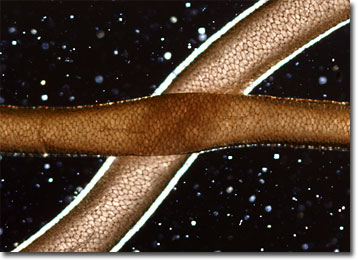Polarized Light Microscopy Digital Image Gallery
Antelope Hair
Antelopes are herbivores that belong to the family Bovidae, which also contains animals such as cattle, sheep, goats, buffalo, and bison. Their common name is derived from the Greek antholops, meaning "brightness of the eye."

Native to Africa and parts of Asia, antelopes exhibit a broad range of variations in appearance and behavior, more than 100 species having been classified. The even-toed ruminants may, for instance, range in size from shoulder heights of one to six feet, and their hollow horns can be short, long, straight, curved, ringed, or spiral. The pronghorn antelopes of North America, however, actually belong to the family Antilocapridae and are not considered true antelopes because each year they shed the outer sheath of their horns, unlike other antelope species. One characteristic that is common to all antelopes is their incredible running speeds that average 60 mph, making them the second fastest animals in the world. The intriguing creatures are capable of reaching such speeds due to the oversized tracheas, huge lungs, and sizeable hearts that facilitate the consumption and processing of large amounts of oxygen.
Over the past 30 years, many species of antelope have become endangered. This development is largely a result of the fact that in addition to the natural predation they suffer from leopards, lions, wild dogs, and other animals, antelopes are hunted by man. One species that is in particularly critical condition is the Tibetan antelope, also known scientifically as Pantholops hodgsonii and commonly as the chiru. These animals have been, and continue to be, hunted extensively for their undercoats, the wool of which is known as shahtoosh, meaning “king of wools” in Persian. Although the endangered status of the chiru makes it illegal to trade and import items derived from them in most countries, their wool can still be found circulating illegally, generally commanding exorbitant prices.
